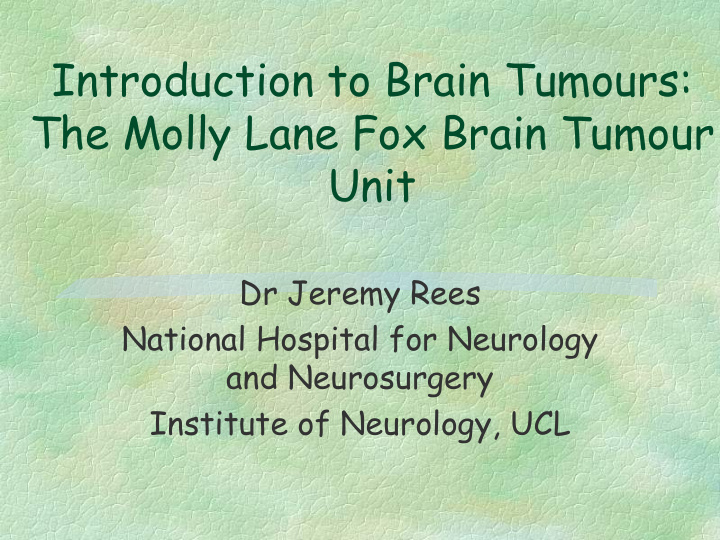



Introduction to Brain Tumours: The Molly Lane Fox Brain Tumour Unit Dr Jeremy Rees National Hospital for Neurology and Neurosurgery Institute of Neurology, UCL
Brain Tumours
A lump in the head? Growth of abnormal cells arising from normal brain structures May be Primary e.g. glioma, germinoma, meningioma – these may be benign or malignant Or Secondary e.g. from breast, lung cancer – these are always malignant
The Cancer Premiership Table
Brain Tumours Across the Ages
Brain anatomy
The Human Brain
The simplified human brain
Structure Function
Medical approach to brain tumours
Position in relation to the brain INTRINSIC EXTRINSIC (e.g. glioma, lymphoma, (e.g. meningioma, nerve germinoma) sheath tumour)
Classification of Brain Tumours CELLULARITY, PLEOMORPHISM, MITOTIC ACTIVITY VASCULAR PROLIFERATION, NECROSIS BENIGN MALIGNANT
WHO Grading System CELLULARITY, PLEOMORPHISM, MITOTIC ACTIVITY VASCULAR PROLIFERATION, NECROSIS I II III IV
WHO Grading System MALIGNANT BENIGN (high grade) (low grade) I II III IV
WHO Grading System MALIGNANT BENIGN (high grade) (low grade) I II III IV transformation
On the scan
On the operating table
Under the microscope Diffuse astrocytoma (WHO grade II)
Frequency distribution of primary intracranial tumours Tumour type Relative frequency Glioma (all types) 60% Meningioma 20% Pituitary adenoma 10% Others 10%
How do brain tumours present?
Headache
Seizure
Neurological deficit
Location and speed of growth Slow – growing tumours rarely cause headache – unless in children at the back of the brain Fast – growing tumours cause headache and other neurological problems e.g. loss of function Tumours at the surface can cause seizures Deep-seated tumours can cause memory loss, confusion and unsteadiness
First presenting symptoms First symptom At hospital presentation Headache 23.5% 46.5% Seizure 21.3% 26.5% Confusion 4.5% 30.6% Personality problem 1.6% 21.6% Visual problem 3.2% 26.1% Language 5.8% 35.5% Unilateral weakness 7.1% 35.8% Unilateral numbness 2.3% 17.1% Unsteadiness 6.1% 41.6% Diplopia 0.3% 10.0% Other 24.2%
Headache, vomiting, blurred vision
Seizure
Confused, off legs
How do we treat brain tumours?
Treatments for Brain Tumours Surgery Biopsy Debulking Resection Oncology Radiotherapy Chemotherapy New agents
The Molly Lane Fox The Molly Lane Fox Brain Tumour Unit Brain Tumour Unit
The problem of Brain The problem of Brain Tumour Tumour Poor survival – – 15% at 5 years for Poor survival 15% at 5 years for malignant tumours tumours malignant Fragmented care - - poor patient Fragmented care poor patient experience experience Complex needs Complex needs Rare disease, therapeutic nihilism Rare disease, therapeutic nihilism Small numbers of clinical trials Small numbers of clinical trials
The Multidisciplinary Team
Brain Tumour Unit Brain Tumour Unit Weekly Multidisciplinary Team Meeting Brain Tumour Office Clinical Trials and links with UCL Cancer Institute UCL Partners Integrated Cancer System Patient Focus Groups, Online patient feedback
Molly Lane Fox Unit Molly Lane Fox Unit First dedicated brain tumour unit nationally £ 2.5 million raised by the National Brain Appeal and Molly’s Fund Mission Statement: ‘to provide multidisciplinary, high-quality, research-based and compassionate treatment, care and support to patients with brain tumours and their families and carers’
Molly Lane Fox Unit Molly Lane Fox Unit A dedicated in-patient space for patients with brain tumours Assessment room for patients in DGHs without the need for admission Treatment room Therapy input Patient experience - quiet room, patient literature etc
And Finally And Finally The dichotomy between medical science and patient care The need to improve the patient experience The need to improve patient outcomes
Any Questions?
Recommend
More recommend